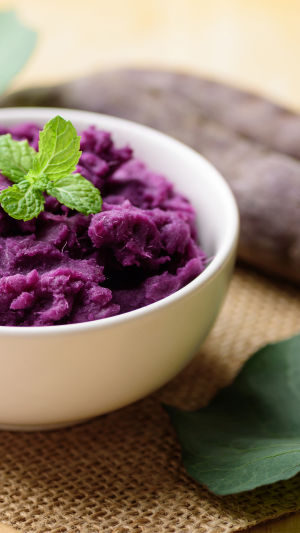Sweet potatoes and purple sweet potatoes often confuse people. Due to their high starch content, they can leave you feeling full, making them a suitable choice as a staple food.
Questions frequently arise about nutritional differences and which one is more suitable for diabetics.
When comparing sweet potatoes and purple sweet potatoes, one common concern is their glycemic index (GI).
Sweet potatoes have a GI of 54, containing 24.7g of carbohydrates per 100g, resulting in a glycemic load (GL) of 13.33.
In contrast, purple sweet potatoes have a GI of 77, with 17.3g of carbohydrates per 100g and a GL of 13.321.
In simpler terms, the impact on blood glucose is almost identical when consuming the same amount of sweet potatoes or purple sweet potatoes. Both fall into the category of medium-load foods, having a moderate impact on blood sugar levels.
This similarity means that sweet potatoes and purple sweet potatoes can be included in a diabetic's diet and serve as a suitable replacement for traditional staple foods.
However, purple sweet potatoes slightly outperform sweet potatoes in certain aspects. When considering food choices for diabetics, it's essential to focus on calories, satiety, and overall nutrition.
First and foremost, diabetics must manage their daily calorie intake to maintain stable blood sugar levels. Sweet potatoes contain 99 calories per 100g, while purple sweet potatoes have only 74 calories per 100g.
This means that, for the same weight, consuming purple sweet potatoes is a better choice in terms of calorie control.
Additionally, when a diabetic needs to supplement 300 calories, eating 400g of purple sweet potatoes is more filling than consuming 300g of sweet potatoes.
Controlling calorie intake is crucial for diabetics, as excessive calorie consumption can lead to hunger and discomfort. Therefore, choosing foods that provide satiety without exceeding calorie limits is a pleasure for diabetics.
Nutritionally, there is little difference between the two types of potatoes. Both sweet potatoes and purple sweet potatoes are primarily composed of carbohydrates and protein.
While purple sweet potatoes contain slightly more protein, with 2.34g/100g compared to sweet potatoes' 1.1g/100g, neither of them is a significant source of protein.
To meet the daily protein requirements, a person needs to consume an impractical amount of potatoes.
When considering calories and satiety, purple sweet potatoes are indeed a more suitable option for diabetics compared to sweet potatoes.
However, in terms of overall nutrition, there is minimal difference between the two. Therefore, both sweet potatoes and purple sweet potatoes can be enjoyed by diabetics as part of a balanced diet.





